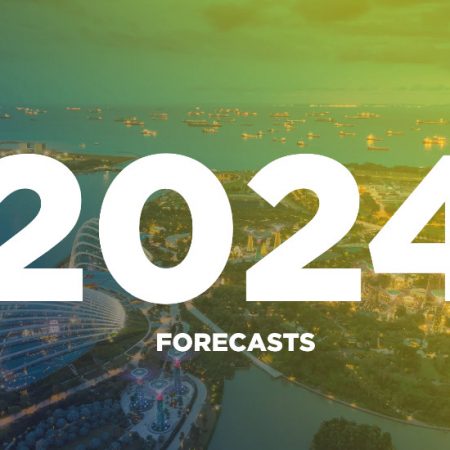Investment outlook
Investment in European property is expected to rebound to €175 billion in 2024, an increase of 20% on the previous year. The rebound will be driven by investors taking advantage of more attractive prices.
Our projection is based on signs the economy is heading towards a soft landing , with inflation dropping sooner than anticipated. This will probably prompt the European Central Bank (ECB) to start loosening monetary policy in the first half of 2024, causing a gradual resurgence in investment. However, due to the lacklustre economic landscape, investment volumes are not anticipated to approach levels seen in the past five years. Investors will maintain their focus on the premium green segment and robust occupier markets, with a strong emphasis on environmental, social and governance (ESG) matters.
In the Middle East, economic sentiment remains positive. Saudi Arabia and the UAE are witnessing significant expansion in the non-oil sector, and construction and real estate play a pivotal role in both countries’ transition away from oil dependency. In the UAE, activity is likely to be led by core and value-add assets, while Saudi Arabia will witness more development finance and opportunistic investments.
Rents outlook
We expect healthy rental growth across most markets in 2024 as vacancy rates remain low.
Despite post-pandemic flexible working models, office vacancy rates average just 8.3% in Europe, up only 300 basis points since before the pandemic. This will drive rental growth, particularly in core western European markets. As occupiers seek best-in-class office buildings, we expect the gap between prime and secondary rents to widen.
In the UAE, vacancy rates of less than 5% across prime locations and Grade A developments led to double-digit rental growth in 2023. That trend is expected to continue; in fact, prime rents may grow by as much as 20% in 2024, thanks to limited new supply.
Rental growth for prime logistics units should also remain strong. Secondary units and markets are expected to come under greater pressure – but should see positive growth despite an increase in supply. In the Middle East, logistics and industrial sectors are benefiting from ongoing structural reforms and an increase in foreign trade.
Vacancy rates for prime high street and retail park space will continue to fall this year, leading to further rental growth. In shopping centres, vacancy rates will be higher, reaching double figures in most European markets, but are at least likely to plateau for prime assets over the course of 2024.
Europe has seen continued strong residential rental growth in most markets. This is likely to continue over the coming year, as the rate of new construction starts falling across much of the continent. However, we expect rental growth to slow in the longer term as affordability becomes a growing challenge for households.
In the UAE, residential rental value growth is likely to moderate, thanks to new launches and handovers. Development activity has picked up in Abu Dhabi, with new master-planned schemes launched across the luxury segment. Average price points have increased, and new benchmark prices for luxury properties set in 2023 are likely to persist. Population growth in Riyadh – projected to hit 7.9 million by 2030, up from 6.4 million in 2015 – has led to a surge in demand for residential properties.
Yields outlook
The expected decline in central bank rates will provide a boost to investment activity. This will lead to a stabilisation of yields towards the middle of the year, with some downward pressure on prime yields in parts of the market.
Logistics yields are expected to remain stable in the first half of the year, while the ECB and Bank of England (BOE) base rates dictate movements. We may see a limited tightening in yields, as central banks start to cut interest rates in the second half of the year.
In the living sectors, we expect yields will continue to soften across all markets, although this trend should bottom out during 2024.
Lack of liquidity in the office sector will continue to exert downward pressure on prices during the first six months of 2024, after which yields will start stabilising for prime offices. Secondary yields will continue to expand.
Overall, we anticipate further yield expansion across the European retail market until mid-2024 – albeit at a slower pace than over the past 12 months – with prime yields bottoming out during the second half of the year.
Savills top picks for EME, 2024
- Prime logistics (UK, Germany, Netherlands, France, Spain, Dubai, Abu Dhabi)
- Prime CBD offices (Paris, Madrid, London, Copenhagen, Dubai, Abu Dhabi, Riyadh)
- Prime multifamily (all large cities, southern Europe, Dubai, Riyadh)
- Small and mid-size grocery stores (all cities with good accessibility)
- Prime retail parks (across Europe, anchored by at least one large supermarket, Dubai, Riyadh)
- Refurbishment of older CBD office stock (undersupplied markets, Berlin, Munich, Frankfurt, Hamburg, Dusseldorf, Cologne, Riyadh, Dubai)
- Modern logistics assets with reversionary potential
- New PBSA schemes (Southern Europe)
- Nascent industrial and logistics sub-sectors, including industrial outdoor storage, self-storage and electric vehicle charging
- Repurposing of distressed real estate assets
- Life science parks across UAE
- Data centres


